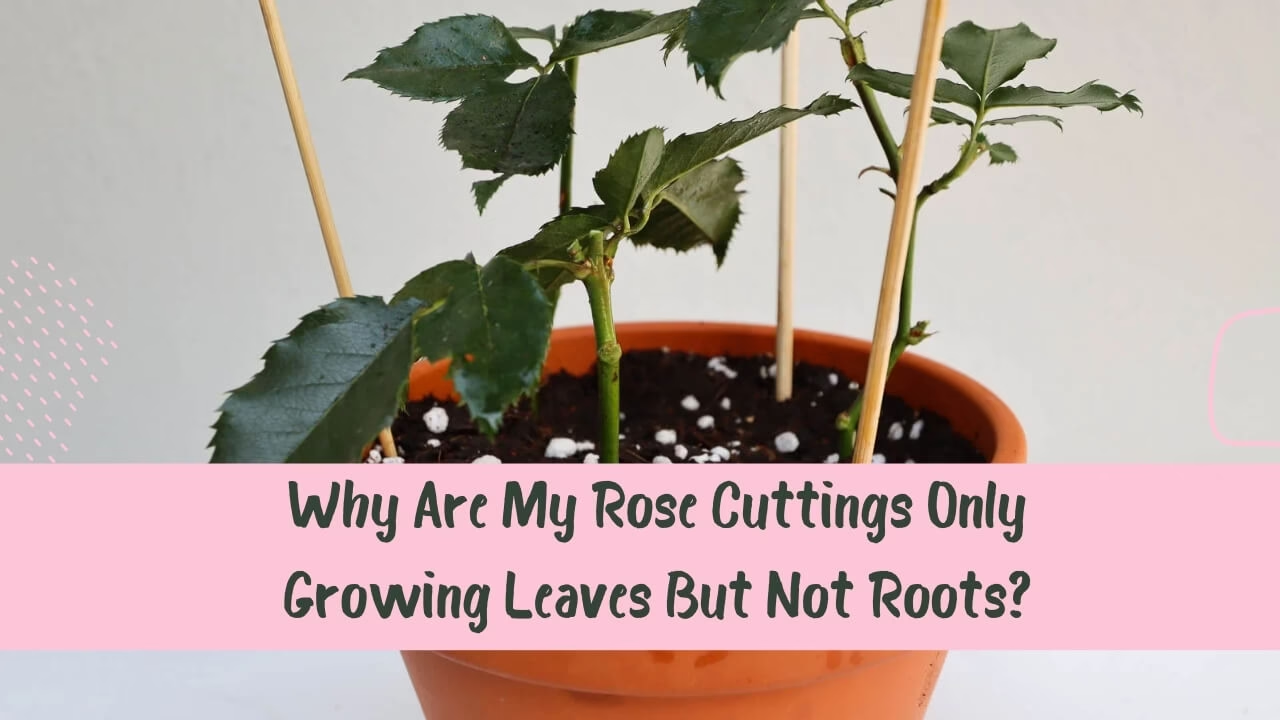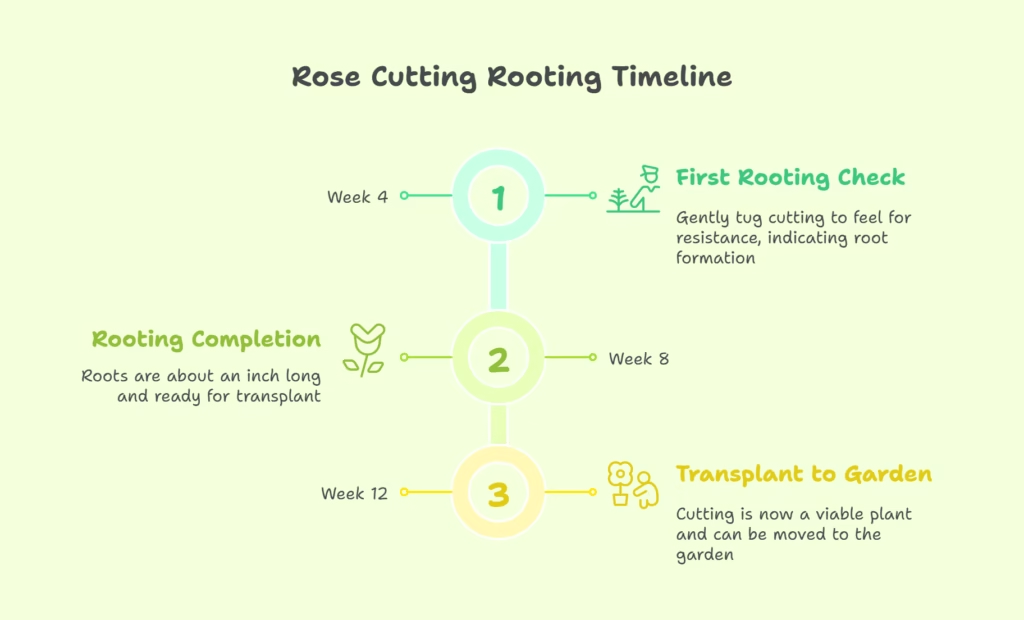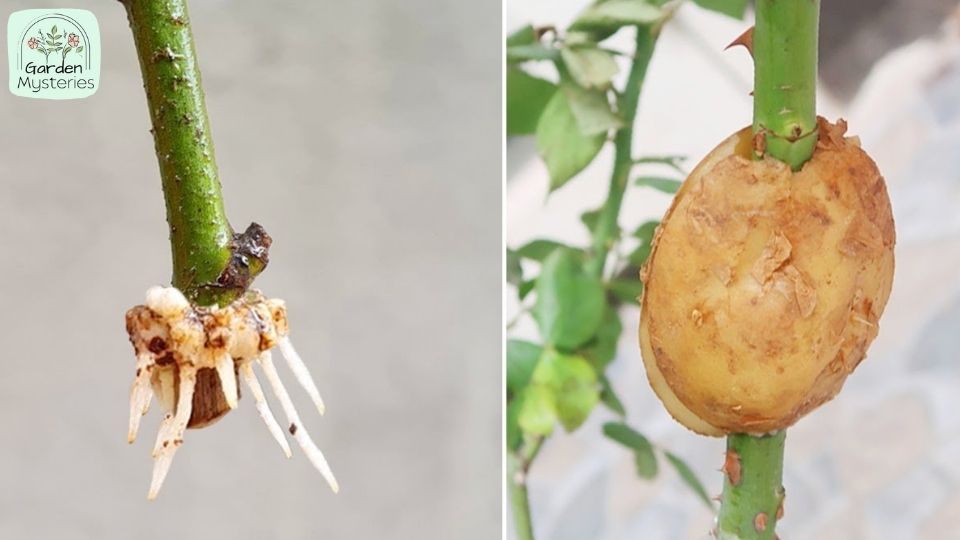
Once I tried to propagate rose from cuttings, and I saw my rose cuttings growing leaves but not roots. So I asked my friend and she said it’s not uncommon. Some of the issues involve insufficient hormones, improper soil moisture, low humidity, disease, overfertilization, etc.
It can happen because of hormones, improper soil moisture, low humidity, disease, overfertilization, and so on. Well, if you are planning to grow rose plants from cuttings, please keep reading. Here, you’ll find something essential that will make your effort successful.
How Long It Takes for Rose Cuttings to Grow Roots?
The time it takes for rose cuttings to develop roots varies, typically ranging from 4 to 8 weeks. Factors influencing this timeline include the rose variety, environmental conditions, and the type of cutting (softwood or hardwood).
More likely, you will see softwood rose cuttings to root faster than hardwood ones. Maintaining consistent moisture and humidity levels, along with providing an optimal temperature between 65-75°F (18-24°C), accelerates root growth.
Using a rooting hormone aids in quicker development. Patience is key; some roses might establish roots sooner, while others might take longer. Regular monitoring is essential, gently tugging the cutting after a few weeks to feel for resistance, indicating root formation.
Once roots are about an inch long, the cutting can be transplanted to a larger pot or the garden. Overall, expect a span of 1.5 to 3 months for rose cuttings to grow roots and become viable plants.
Common Mistakes to Avoid When Propagating Roses from Cuttings
Trying to grow roses from cuttings can be rewarding, but a few common mistakes can easily stop your progress. If you’re noticing leaves but no roots, or your rose cuttings seem stuck, you might be overlooking a key part of the process. Here are some crucial errors to avoid when attempting rose propagation.
Using the Wrong Cutting Type
Not all rose stems are created equal when it comes to rooting. Choosing too old or too woody of a stem can slow down or stop root development altogether. For best results, use semi-hardwood or softwood cuttings—ideally 6–8 inches long, with at least two leaf nodes. This type of cutting holds the right balance of flexibility and stored energy, which supports early root growth.
Ignoring the Importance of Rooting Hormone
Many beginners try to grow roses from cuttings without using rooting hormone, thinking it’s optional. While some cuttings may root naturally, using a hormone powder or gel significantly increases success. It encourages faster root development and reduces the chance of rotting or fungal issues during early growth.
Overexposing to Sunlight
While roses love sunlight once established, direct sunlight during propagation can harm unrooted cuttings. Strong sun can dry them out, leading to leaf wilt and failed rooting. Place cuttings in bright but indirect light to allow them to focus on developing roots before strong growth.
Using the Wrong Growing Medium
Regular garden soil can be too heavy or poorly drained, causing root rot or poor aeration. Instead, use a light, well-draining mix, like perlite and peat moss or a seed-starting mix. Good airflow around the base of the cutting is crucial for successful rose propagation.
Reasons Why My Rose Cuttings Have Leaves But No Roots?
Here are more reasons why your rose cuttings growing leaves but not roots, along with additional explanations:
Root Zone Temperature
Roses generally require warm soil temperatures for root development. If the root zone isn’t warm enough, it can hinder root growth even if the plant has enough stored carbohydrates. Using a heating mat or placing the cuttings in a warm location can help promote root growth.
Stored Carbohydrates
While stored carbohydrates are essential for initial growth, having enough stored energy might not be sufficient for root development. Roots require a steady supply of nutrients to grow, and a balance between carbohydrate availability and nutrient uptake is crucial.
Low Humidity
Roses thrive in humid environments, especially during the rooting phase. Low humidity levels can lead to excessive moisture loss through the leaves, which can stress the cutting and prevent root development. Consider using a humidity dome or misting the cuttings roses regularly to maintain proper humidity levels.
Moisture Management
Keeping the cuttings too dry or too wet can both hinder root growth. If the cuttings roses dry out, they can’t take up water and nutrients. On the other hand, overly wet conditions can lead to fungal issues and root rot. It’s important to find the right balance by ensuring the growing medium is consistently moist but not waterlogged.
Fungal Infections
Fungal infections can occur if the cuttings are kept in high humidity and damp conditions without proper air circulation. Also, fungi can attack the stem and hinder root development. To prevent fungal infections, provide good ventilation and ensure the leaves don’t stay wet for prolonged periods.
Cutting Quality
The quality of the cutting itself can influence its ability to develop roots. Choose healthy, disease-free stems for propagation. A cutting with any existing diseases or damage might struggle to develop roots, even if it produces leaves.
Rooting Hormones
Using rooting hormones can greatly enhance the chances of successful root development. These hormones stimulate root growth and increase the cutting’s ability to produce roots.
Rooting Medium
The medium in which you’re trying to root the cuttings matters. A well-draining medium with good aeration is important for root development. A heavy or compacted medium can impede the growth of new roots.
Light Levels
While light is essential for photosynthesis and leaf growth, excessive light can stress the cuttings and divert energy away from root development. Moreover, providing adequate but not excessive light is crucial during the initial stages of propagation.
Patience
Root development can take time. Some rose varieties might require longer periods to develop roots than others. Patience is key, as premature attempts to transplant cuttings with leaves but no roots can damage the developing root system.
To improve your success with rose cutting propagation, focus on maintaining optimal conditions for root development, including proper temperature, humidity, moisture levels, and hygiene practices. Experimenting with different rose varieties and adjusting your approach based on their specific needs can also lead to better results.
If you are interested in the causes and quick fix for orchid root turning brown, you should go through this article.
Cause & Solutions: Rose Cuttings Have Leaves But No Roots
Let’s have a quick review of the problems, like rose cuttings growing leaves but not roots, and solutions related to rose cuttings growing leaves but not roots:
| Factors | Reasons | Solutions |
| Root Zone Temperature | Insufficient warmth inhibits root growth | Use a heating mat or warm location |
| Stored Carbohydrates | Carbohydrates alone may not support root growth | Ensure a balance between carbs and nutrient uptake |
| Low Humidity | Dry conditions lead to excessive moisture loss | Use a humidity dome or mist regularly |
| Moisture Management | Inconsistent moisture levels hinder root growth | Maintain medium moistness, but avoid waterlogging |
| Fungal Infections | High humidity and poor ventilation can cause it | Ensure good air circulation and hygiene |
| Cutting Quality | Disease or damage in the cutting affects rooting | Use healthy, disease-free cuttings |
| Rooting Hormones | Lack of stimulation for root growth | Apply rooting hormone for enhanced root growth |
| Rooting Medium | Inadequate medium can impede root development | Use well-draining, aerated rooting medium |
| Light Levels | Excessive light stresses the cuttings | Provide appropriate, not excessive, light |
| Patience | Roots need time to develop | Wait for an adequate period before transplanting |
These potential causes and solutions address the issue of rose cuttings producing leaves but not developing roots. Carefully assess each factor, make necessary adjustments, and monitor progress. Remember that successful rooting requires a balance of favorable conditions and patience.
How to Treat Rose Cuttings That Have Leaves But No Roots
Treating rose cuttings that have leaves but no roots requires addressing potential issues that might be hindering root development. Here’s a step-by-step approach to help you:
Step 1: Assessment
Examine the cuttings roses in potato closely to rule out any visible problems like diseases or physical damage.
Step 2: Rooting Hormone
If you didn’t use rooting hormone initially, dip the cut ends of the rose cuttings in a rooting hormone powder or gel. This helps stimulate root growth.
Step 3: Check Moisture
Ensure that the soil or rooting medium is consistently moist but not waterlogged. Inadequate or excessive moisture can affect root development. Mist the leaves occasionally to maintain humidity around the cuttings.
Step 4: Humidity Dome
If humidity is low, create a makeshift humidity dome using a clear plastic bag or a transparent container to trap moisture around the cuttings. This encourages root development.
Step 5: Temperature Control
Maintain a stable temperature within the recommended range for rooting rose cuttings to root (usually around 65-75°F or 18-24°C). Extreme temperatures can impede root growth.
Step 6: Rooting Medium
Check that you’re using a well-draining, sterile rooting medium that provides aeration to the cuttings’ base. Adjust the medium if needed.
Step 7: Time and Patience
Remember that root development takes time. Be patient and continue to care for the cuttings, even if it takes several weeks.
Step 8: Inspect Cutting Type
If you use hardwood cuttings, they might naturally take longer to root. Research the specific rose variety you’re propagating to understand its typical rooting timeline.
Step 9: Avoid Overfertilization
Discontinue or reduce fertilization during the rooting process, as excessive nutrients can inhibit root growth.
Step 10: Sanitation
Ensure cleanliness in your tools and planting environment to prevent diseases from affecting the cuttings.
Step 11: Gentle Tug Test
After a few weeks, perform a gentle tug test. If you feel resistance when pulling lightly, it indicates root growth. If not, give it more time.
Step 12: Reevaluation
If you see no improvement after an extended period (several months), consider taking fresh cuttings and starting the process over, addressing any potential issues from the beginning.
By addressing these factors and providing optimal conditions, you can increase the chances of your rose cuttings in potatoes developing roots successfully. Also, remember that not all cuttings will root, so don’t be discouraged if you encounter rose cuttings growing leaves but not roots along the way.
Best Conditions for Rose Cuttings to Root Successfully
If you’re trying to grow roses from cuttings, creating the right environment is just as important as selecting the cutting itself. Without the proper rooting conditions, even healthy cuttings may fail to develop roots. Below are the ideal conditions for rose cuttings to root successfully and become thriving plants.
Temperature Range for Root Development
The best temperature range for rose cuttings to root is between 65°F and 75°F (18°C to 24°C). Staying within this window helps support active root formation while avoiding stress from cold or heat. If temperatures drop too low, root growth can stall. In colder areas, using a heating mat can help maintain the right soil temperature during the propagation phase.
Light Exposure Needed During Rooting
Rose cuttings need light to stay healthy, but direct sunlight can be too harsh during early rooting. Aim for bright, indirect light, like near a window with a sheer curtain or in a lightly shaded outdoor area. Too much sun can dry out the leaves before roots develop, which reduces your success rate.
Best Humidity Level for Rose Cuttings
High humidity is essential to keep moisture in the leaves while the roots are still forming. Try to maintain humidity levels around 70% to 80%. You can use a plastic bag, humidity dome, or DIY greenhouse setup to trap moisture and prevent the cuttings from drying out.
Ideal Watering Routine for Rooting Success
When learning how to root rose cuttings, watering can make or break your effort. Keep the rooting medium consistently moist but not soggy. Overwatering can lead to fungal issues, while underwatering can dry out the stem. Misting the cuttings gently every couple of days helps maintain the right moisture level for rooting success.
Tips to Grow Rose Plants from Cuttings
Growing rose plants from cuttings can be a rewarding process. Here are some tips to help you successfully propagate rose plants from cuttings:
- Choose Healthy Cuttings: Select young, healthy stems from a mature rose plant. Choose stems that are about 6-8 inches long and have at least two sets of leaves.
- Timing: Take cuttings during the plant’s dormant season, usually in late winter to early spring or late fall. Softwood cuttings are typically taken in spring, while hardwood cuttings are taken in late fall.
- Prepare the Cuttings: Use clean, sharp pruning shears to make clean cuts just below a leaf node. Remove any flowers or buds from the cutting.
- Rooting Hormone: Dip the cut end of the rose cutting into a rooting hormone powder or gel. This helps stimulate root growth.
- Planting Medium: Use a well-draining rooting medium, such as a mixture of perlite and peat moss, or a commercial seed-starting mix.
- Planting Depth: Plant the cuttings about 2-3 inches deep in the rooting medium. You can plant multiple cuttings in the same container.
- Humidity Dome: Place a clear plastic bag or a plastic dome over the cuttings to create a humid environment that promotes rooting.
- Light: Place the cuttings in bright, indirect light. Avoid direct sunlight, as it can cause the cuttings to overheat.
- Temperature: Maintain a consistent temperature between 65-75°F (18-24°C) for optimal root development.
- Watering: Keep the soil evenly moist, but not waterlogged. Mist the leaves occasionally to maintain humidity.
- Patience: Rooting can take several weeks to a few months. Be patient and resist the urge to disturb the cuttings.
- Transplanting: Once the cuttings have developed roots that are about an inch long, carefully transplant them into individual pots with a well-draining potting mix.
- Hardening Off: Before planting the rooted cuttings outdoors, gradually acclimate them to outdoor conditions by placing them outside for increasing periods over a week or two.
- Planting Outdoors: Choose a sunny location with well-draining soil for transplanting the rose plants. Space them appropriately based on the rose variety’s mature size.
- Regular Care: Provide regular watering, fertilization, and proper pruning to encourage healthy growth.
- Winter Protection: In colder climates, protect your young rose plants from harsh winter conditions by mulching around the base and providing adequate insulation.
- Monitor and Prune: Regularly monitor the growth of your propagated rose plants. Prune away any dead or unhealthy growth to promote overall health.
Remember that not all cuttings will root successfully, so it’s a good idea to take multiple cuttings to increase your chances of success. With proper care and attention to detail, you can enjoy the satisfaction of growing beautiful rose plants without rose cuttings growing leaves but not roots.
If you check on the internet how to grow a rose from a cutting in potatoes, you can try it too. In the future, I will cover this fact after I have experienced it myself.
FAQs
How can I ensure proper oxygen supply for root development in rose cuttings?
Adequate aeration is essential for root growth. Use well-draining soil, avoid compacted media, and ensure proper watering practices to maintain oxygen availability for the developing roots.
Can you really grow a rose cutting in a potato?
Yes, you can! Growing a rose in a potato is a creative propagation method. The potato helps retain moisture and gives the cutting a stable environment while roots form.
Can the wrong type of cutting affect root growth in roses?
Absolutely. Different rose varieties root at varying rates. Some might require different propagation methods, like grafting. Research the specific rose variety to understand its rooting behavior.
Are you trying to grow new shoots in ZZ plants but have not succeeded yet you can visit the article. I hope it will guide you to success.
borshon96
Recommended

9 Effective Tips for Balcony Gardens for Beginners

Best Homemade Fertilizer: Banana Peel for Plants


Philodendron Neon Heartleaf: Your Most Obedient Houseplant




